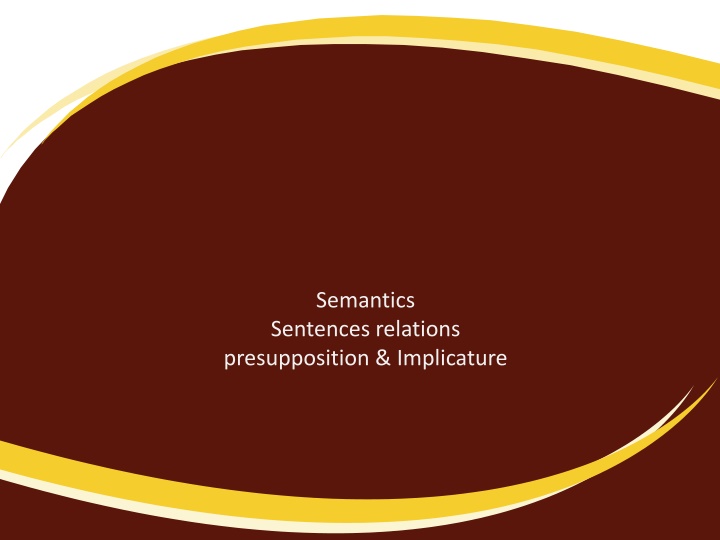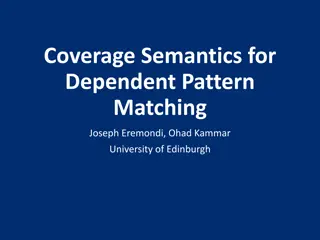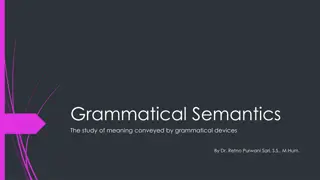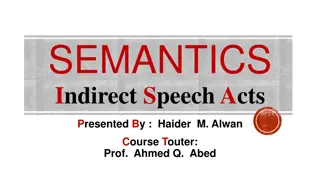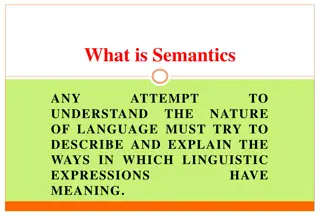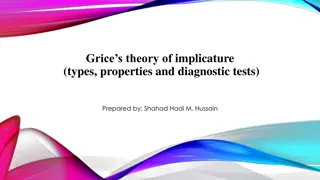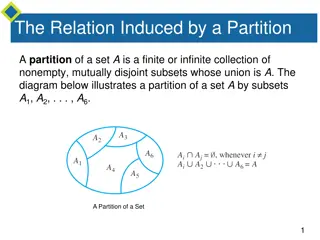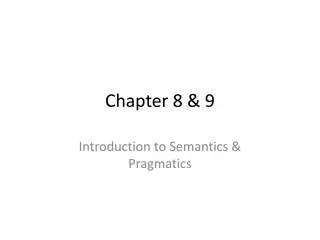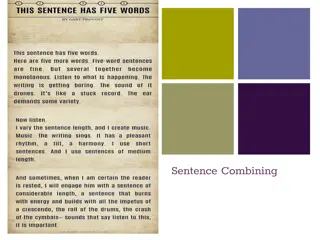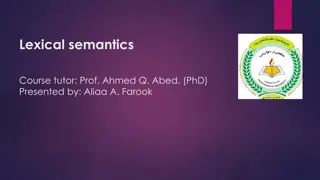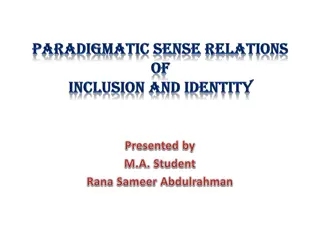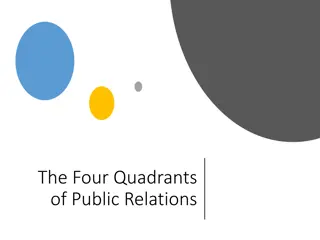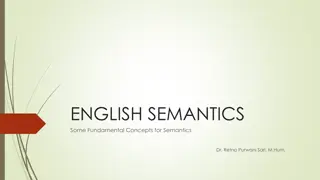Semantics Sentences relations presupposition & Implicature
This content delves into the semantic relations between sentences, emphasizing presuppositions and implicatures. It explores the interplay of semantics and pragmatics in deriving intended meanings within specific contexts, discussing various types of sentence relations and the significance of presupposition in language understanding.
Download Presentation

Please find below an Image/Link to download the presentation.
The content on the website is provided AS IS for your information and personal use only. It may not be sold, licensed, or shared on other websites without obtaining consent from the author.If you encounter any issues during the download, it is possible that the publisher has removed the file from their server.
You are allowed to download the files provided on this website for personal or commercial use, subject to the condition that they are used lawfully. All files are the property of their respective owners.
The content on the website is provided AS IS for your information and personal use only. It may not be sold, licensed, or shared on other websites without obtaining consent from the author.
E N D
Presentation Transcript
Semantics Sentences relations presupposition & Implicature
TODAYS OVERVIEW Introduction Sentences relations Summary implicature presupposition
Introduction in the previous lectures we have tackled the semantic relations which hold between words . In this lecture we shall move to the semantic relations between sentences, as well as the correlation between semantics & pragmatics which help to infer the intended meaning in the right context. And we shall see that In the uses of language what is meant is often more than , or different from, what has actually been said Meaning in Pragmatics and Semantics: Meaning in pragmatics is defined as relative to the speaker (or user) of the language, as well as to the hearer how could he\she infer what the speaker implicates. Meaning in semantics is defined as a property of expressions of a given language, in abstraction from particular situations, speakers or hearers. .
Sentences relations Richard Montague (1974)has hypothesized that the tools of logic can help us to represent sentences meaning & relations.Moreover Saeed (2003) identifies six types of sentences relations which are: 1- synonymy : when A sentence has the same meaning of B sentence. e.g. My brother is bachelor. My brother has never married 2- entailment: A entails B , we know if A then automatically B. E.g. The anarchist assassinated the emperor. The emperor is dead. 3- contradiction:A is inconsistent with B. e.g. My brother Sam has just came from Rome. My brother Sam has never been to Rome. 4-Presupposition:B is part of the assumed background against which A is said. E.g. I regret eating your sandwich. I ate your sandwich. 5- Tautology: A is automatically true by virtue of its own meaning. e.g. Rich people are rich. 6- contradiction within A itself: A asserts & denies the same thing. E.g. He is a murderer but he`s never killed any one.
Presupposition In ordinary language to presuppose something means to assume it, in the following sentences the A sentence is said to presuppose the B sentence: A- He gave up smoking Kent cigarettes . B- He used to smoke Kent cigarettes. A-Her husband is handsome. B- she has a husband. A- I don t regret leaving London. B- I left London.
Presupposition has been an important topic in semantics , as well as in pragmatics - presupposition can be seen as coinciding with the development of pragmatics as a sub-discipline. The basic idea, is that semantics would deal with conventional meaning, those aspects which do not seem to vary too much from context to context, while pragmatics would deal with aspects of individual usage and context-dependent meaning. The importance of presupposition to the pragmatics debate is that, it seems to lie at the borderline of such a division. In some respects presupposition seems like entailment: a fairly automatic relationship, involving no reasoning, which seems free of contextual effects. In other respects, though, presupposition seems sensitive to facts about the context of utterance
Two approaches to presupposition We can identify two possible types of approach to presupposition, arising from different ways of viewing language 1-According to the first approach sentences are viewed as external objects :Meaning is seen as attribute of sentence rather than something constructed by the participants.we don't worry too much about the process of producing them, or the individuality of the speaker or writer and their audience 2-the second approach views sentences as the utterances of individuals engaged in communication act . The aim here is modeling the strategies that speakers & hearers use to communicate with one another. The first approach is essentially semantic and the second pragmatic.
Or from listener's viewpoint in which presupposition can be seen as one of a number of inferences that the listener might make on the basis of what the speaker has just said. Communication can be viewed from the speaker's viewpoint and talk about presupposition as part of the task of packaging an utterance; John`s brother has just got back from Texas. John has a brother. We can adopt the sentences-as-external-objects approach to identify a semantic relationship between these two sentences
Presupposition as a truth relation. Step 1: If p (the presupposing sentence) is true then q (the presupposed sentence) is true. Step 2: If p is false, then q is still true. Step 3: If q is true, p could be either true or false P q T T F T F\T T
If it is true that John's brother has come back from Texas, it must be true that John has a brother. If it is false that John's brother has come back from Texas (if he is still there, for example), the presupposition that John has a brother still survives. If is true that John has a brother, it doesn't tell us anything about whether he has come back from Texas or not: we just don't know.
So viewing presupposition as a truth relation allows us to set up a truth table, and allows us to capture an important difference between entailment and presupposition. -If we negate an entailing sentence, then the entailment fails; -but negating a presupposing sentence allows the presupposition to survive. Take for example the entailment pair in : a. I saw my father today, b. b. I saw someone today. If we negate a then it no longer entails b: a-I didn't see my father today, b. I saw someone today. While: . a- The mayor of Liverpool is in town, b. There is a mayor of Liverpool. If we negate a the resulting sentence still has the presupposition, a-The mayor of Liverpool isn't in town today, b. There is a mayor of Liverpool.
presupposition failure . One phenomenon which has traditionally caused problems for a truth relations approach but may be less problematic in an interactional presupposition failure. It has been observed that using a name or a definite description to refer presupposes the existence of the named or described entity:so the a sentences below presuppose the b sentences: approach is P q T T F T T\F T Tv F F a. Ronald is a vegetarian, b. Ronald exists. a. The King of France is bald, b. There is a King of France.
truth-value gap If A statement can be neither true nor false, it opens a nasty can of worms. How many degrees in between are possible? A good deal of the attractive simplicity of the truth-based approach seems in danger of being lost. It is a problem that has generated a number of solutions in the philosophical literature; : The King of France is bald is true if and only if: a-at least one thing is the king b-at most one thing is the king c-whatever is the king is bald.
Presupposition triggers . We have seen that the use of a name or definite description gives rise to a presupposition of existence. Other types of presupposition are produced by particular words or constructions, which together are sometimes called presupposition triggers Some of these triggers derive from syntactic structure, for example the cleft construction in 1 and the pseudo-cleft in 2 share the presupposition in 3: 1-It was his behaviour with frogs that disgusted me. 2-What disgusted me was his behaviour with frogs. 3-Something disgusted me.
Many presuppositions are produced by the presence of certain words. Many of these lexical triggers are verbs. For example, there is a class of verbs like regret and realize that are called factive verbs because they presuppose the truth of their complement clause. Compare sentences -6-and -7-below: only the sentence with the factive realize presupposes-8-. There is no such presupposition with the non-factive verb think. 6-Sean realized that Miranda had dandruff. 7-Sean thought that Miranda had dandruff. 8- Miranda had dandruff.
presuppositional behaviour seems sensitive to context. While a given sentence always produces the same set of entailments, it seems that this is not true of presuppositions. Levinson (1983) gives as an example the type of presupposition usually triggered by time adverbial clauses, e.g. a presupposing b below: a She died before she finished her thesis, b. She finished her thesis. Here presupposition is blocked or cancelled by our general knowledge of the world: dead people do not normally complete unfinished theses. defeasibility,the cancelling of presuppositions If presuppositions arise or not depending on the context of knowledge, this suggests that we need an account of them that can make reference to what the participants know, as in an interactional approach, rather than an account limited to formal relations between sentences.
Pragmatic theories of presupposition Some writers (for example Leech 1981) have divided presuppositions into two types: one, semantic presupposition, amenable to a truth-relations approach; another, pragmatic presupposition, which description. In contrast, Stalnaker (1974) argued that presupposition is essentially a pragmatic phenomenon: part of the set of assumptions made by participants in a conversation, which he termed the common ground. A pragmatic view of presupposition is also proposed by Sperber and Wilson (1995), who argue that presupposition is not an independent phenomenon but one of a series of effects produced when the speaker employs syntactic structure and intonation to show the hearer how the current sentence fits into the previous background requires an interactional
Implicature to mean more than what we actually say. What is your opinion about A? - He`d share his last crust of bread with you. - The answer implies that A is kind & generous. Much of the information that is conveyed from the speaker to the addressee in day to day conversation is implied. In some cases, it is not clear whether the speaker intends the addressee to draw a particular inference or not . And this opens the way for misunderstanding & misrepresentation.
-the term 'implication' is normally used in philosophical semantics to refer to the truth-functional relation of material implication; and this in turn is distinguished from strict implication, or entailment. -The term implicature* was introduced into the philosophy of language by Grice in his William James lectures in 1967/8 (cf. Grice, 1975).. -Grice's notion of implicature is intended to cover at least some of the difference between the broader, everyday, notion of implication and the narrower, philosophical, notion of entailment. notion of implicature rests upon a distinction between what is actually said and what is implied (but not entailed) in saying what is said
It is cold in here It is cold where he is. the heating should be turned up
According to Paul Grice in his 1967\8 William James , there are two kinds of implicatures: implicature Conventional conversational 1- conventional :this kind of implicature depends on something other than what is truth conditional in the conventional use, or meaning. 2- conversational: conversational implicature derive from a set of more general principles which regulate the proper conduct of conversation.
It has been argued that and & but in English can be accounted for in terms of the notion of conventional implicature .Grice et al would say that the following sentences have the same propositional content,Which means that they have the same meaning. A-He is poor and he is honest. B-He is poor but he is honest . Some native speakers of English operating with an everyday notion of meaning would disagree. They can say that the use of but in contrast with and indicates that the speaker feels that there is some kind of contrast between the conjoined propositions.
Conventional implicature An implicature that is Part of lexical item`s (or expression`s )agreed meaning , rather than derived from principles of language use , and not part of the conditions for the truth of the item or expression. connectors such as "but', moreover, "so" and certain modifiers such as "even", and "still" exhibit the peculiar property of having conventional non-truth-conditional meaning. Unlike what these words contribute to the import of a sentence is determined by their conventional meaning .yet unlike ordinary conventional meaning ,their contribution does not affect the sentence`s truth conditions
She is rich but she is unhappy. Ali`s research is impressive ; moreover , she is a gifted teacher John`s door is open, so he is in his office It`s still raining. The first sentence implies but doesn t actually says that Sara is unhappiness contrast with her wealth. Similarly uttering 2-4 suggests or implies without actually saying that Ali`s gift for teaching is an additional consideration; John`s being in his office is a consequence of his door`s being open.,
Make your conversational contribution such as is required, at the stage at which it occurs, by the accepted purpose or direction of the talk exchanged in which you are engaged The cooperative principle has four sub-parts, four rules or maxims that people involved in conversations tend to respect: quantity, quality, relation and manner: Quantity, (i) Make your contribution as informative as is required (for the current purposes of the exchange); (ii) do not make your contribution more informative than is required. - A: Where are you going? B: I m going to the post office. one can violate this maxim by making his contribution more informative: A: Are you going to work tomorrow? B: I am on jury duty, but I ll have to go to the doctor in the evening. I have asked the manager for permission In this example, B s reply violates m
Quality. Try to make your contribution one that is true: (i) Do not say what you believe to be false; (ii) Do not say that for which you lack adequate evidence. A- Why did you come late last night? B: The car was broken down Can be violated by giving wrong information: A: The Teheran s in Turkey, isn t teacher? B: And London s in America I suppose. Relation.Be relevant: A: Where is my box of chocolates? B: It is in your room. In the example, B s reply relates to the question, not talking about something else. Example of disobeying / violation A: Where s my box of chocolates? B: I don t know mine either. Manner. Be perspicuous: (i) Avoid obscurity of expression; (ii) Avoid ambiguity; (iii) Be brief (avoid unnecessary prolixity); (iv) Be orderly. A: Where was Alfred yesterday? B: Alfred went to the store and bought some whiskey. . Example of disobeying / violation: A: Why was he arrested? B: He stole the money from the ban.
Grice Maxims & troublesome phenomena 1-metaphorical interpretation. metaphorical interpretation enable the addressee to calcu- late (or compute) the intended meaning of the utterance as a function of its literal meaning and of the context in which it is uttered A tiger named John John is a tiger John plays the role of a tiger John is aggressive
'Do you mind if 1 smoke? 1- information-seeking question 2- request xI want to watch t.V now. y: You have not put your toys away. Irrelevant answer to express refusal
Grice's conversational implicatures properties defeasibility. To say that implicatures are defeasible is to say that their validity is context-dependent and that in particular contexts they can be cancelled without contradiction or any other kind of anomaly. For example, the conjunction of two clauses by means of and, as in John arrived late and missed the train, there is a temporal and/or causal connexion between the situations described in the two conjoined clauses. John missed the train because he arrived late
scalar implicatures A scalar implicature is a quantity implicature based on the use of an informationally weak term in an implicational scale. . scalar implicatures involving quantifiers, such as 'some' and 'many1, and numerals (as well as modal, evaluative adjectives and certain other classes of expressions}. The Browns have two daughters will normally implicate that the Browns have only (i.e., no more than) two daughters (and in many contexts it will also implicate that they have no sons; Have the Browns got any children?). But the implicature is readily cancelled, in an appropriate context, by adding, for example, - in fact, they have three.
Calculability Calculability you can trace a line of reasoning leading from the utterance to the implicature, and including at some point the assumption that the speaker was obeying the rules of conversation to the best of their ability. See below. A: Will Sally be at the meeting? B: Her car broke down. +> Sally will not be at the meeting Person A reasons: (1) I assume B is following the rule of relevance. (2) His remark would not be relevant unless the fact that Sally's car has broken down is relevant to whether or not she will be at the meeting. (3) I know that when people's cars break down often they cannot get to work, or cannot get there on time.
non-detachability An implicature is non-detachable if it is inseparably attached to the meaning of an utterance and docs not derive merely from its form. conversational implicature is attached to the semantic content of what is said, not to the linguistic form. John's a genius. b. John's a mental prodigy. c. John's an exceptionally clever human being. d. John's an enormous intellect. e. John's a big brain. ex. 8-10 John's an idiot.
